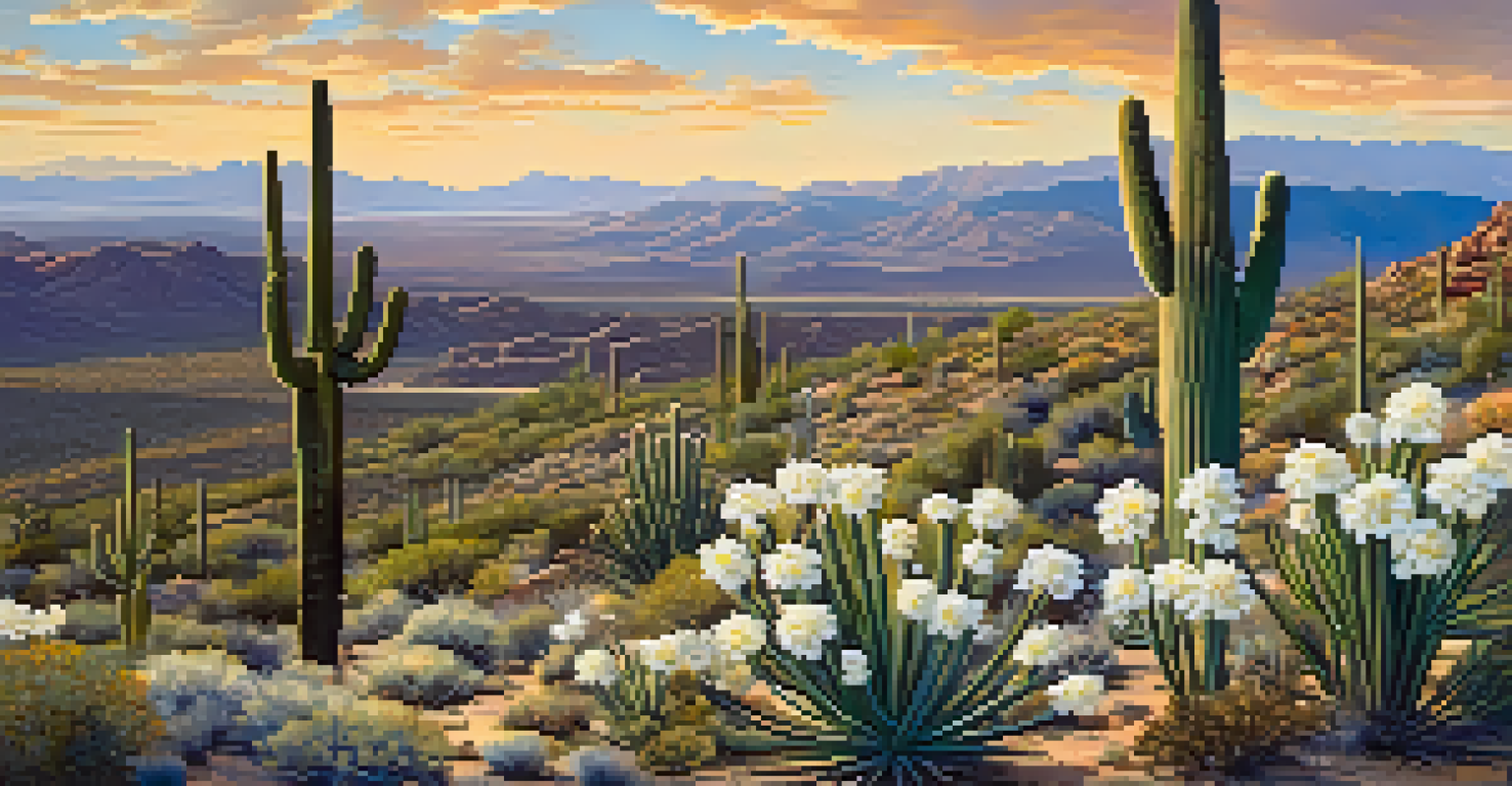Discovering the Unique Flora of America's National Parks

The Importance of Flora in National Parks
Flora plays a crucial role in the ecosystem of national parks, offering food and habitat for countless species. These plants help maintain the balance of nature, contributing to air quality and soil health. The variety of flora found in these parks is not just beautiful; it's essential for the survival of many animals and insects that depend on them.
In every walk with nature one receives far more than he seeks.
By understanding the unique plant life in each park, visitors can appreciate the delicate interconnections within these ecosystems. For instance, wildflowers are not only stunning to look at, but they also attract pollinators like bees and butterflies, which are vital for plant reproduction. This intricate web of life showcases the importance of preserving these natural habitats.
Moreover, each national park has its own signature flora that reflects its climate and geography. From the towering sequoias in California to the colorful desert flora of the Sonoran Desert, these plants tell the story of the land. This rich diversity is a testament to the beauty and complexity of America's natural heritage.
Iconic Plants of the National Parks
When we think of national parks, certain plants often come to mind. For instance, the giant sequoias found in Sequoia National Park are among the largest trees on Earth, standing as ancient sentinels of time. Their massive trunks and lofty canopies create a breathtaking sight that draws visitors from around the globe.

In contrast, the unique Joshua trees of Joshua Tree National Park embody the rugged desert landscape of Southern California. These spiky, twisted trees thrive in arid conditions and are a symbol of resilience in the face of harsh climates. Their unusual appearance adds a touch of whimsy to the stark desert scenery.
Flora Supports Ecosystem Health
The diverse plant life in national parks is essential for maintaining ecological balance, providing food and habitat for various species.
Another remarkable plant is the blooming cactus found in the Saguaro National Park. The iconic saguaro cactus can grow to be over 40 feet tall and live for over 150 years. Its striking flowers bloom only for a short time each year, creating a spectacular display that is a must-see for park visitors.
Exploring Diverse Ecosystems
America's national parks are home to an array of ecosystems, each supporting different types of flora. From lush forests to arid deserts, these environments foster unique plant communities. For example, the rainforests of Olympic National Park are teeming with ferns and mosses, creating a vibrant undergrowth that thrives in the moist climate.
The clearest way into the Universe is through a forest wilderness.
On the other hand, the alpine tundra found in Denali National Park showcases a different kind of resilience, where hardy plants like dwarf willows and mosses flourish in rocky, cold conditions. These plants have adapted to survive extreme temperatures and short growing seasons, illustrating nature's ingenuity.
This diverse range of ecosystems not only enriches the landscape but also provides various habitats for wildlife. Each park tells a story through its flora, revealing how plants adapt to their surroundings and the intricate relationships they share with other organisms.
The Role of Conservation in Protecting Flora
Conservation efforts are vital for protecting the unique flora found in national parks. As climate change and human activity threaten these ecosystems, park management teams work tirelessly to ensure the survival of various plant species. This includes monitoring plant health, restoring habitats, and implementing measures to combat invasive species.
For example, in Great Sand Dunes National Park, efforts are underway to protect native plant species that are endangered due to habitat loss. By actively engaging in conservation practices, park staff can help maintain the delicate balance of these ecosystems, allowing flora and fauna to thrive together.
Conservation is Key for Flora
Active conservation efforts are crucial for protecting unique plant species from climate change and human impact in national parks.
Visitors can also play a role in conservation by following park guidelines and practicing Leave No Trace principles. Simple actions like staying on designated trails and not picking plants can significantly contribute to the preservation of these unique landscapes for future generations.
Seasonal Changes and Their Impact on Flora
The changing seasons have a profound impact on the flora found within national parks. Spring brings a burst of color as wildflowers bloom, while summer provides a lush backdrop of greenery. Autumn transforms the landscape with vibrant hues of red, orange, and yellow, creating picturesque scenes that attract photographers and nature lovers alike.
In winter, many plants enter a dormant phase, adapting to the cold and conserving energy. This period of rest is crucial for their survival, allowing them to regenerate and thrive when warmer weather returns. Understanding these seasonal cycles can deepen our appreciation for the resilience of nature.
Visiting parks during different seasons offers a unique opportunity to witness the dynamic changes in flora. Each season showcases the beauty and diversity of plant life, reminding us of the ever-evolving tapestry of our natural world.
The Impact of Climate Change on National Park Flora
Climate change poses significant challenges to the flora in America's national parks. Rising temperatures and shifting weather patterns can disrupt the delicate balance of ecosystems, leading to changes in plant distribution and health. Some species may struggle to adapt, while others may flourish, altering the landscape as we know it.
For instance, studies show that earlier spring thaw dates can cause mismatches between flowering plants and their pollinators, affecting reproduction. This interdependence highlights the urgency of addressing climate change to protect not just the plants, but the entire ecosystem that relies on them.
Seasons Affect Plant Life
The changing seasons significantly influence the flora in national parks, showcasing the resilience and adaptability of plant species.
National parks serve as vital spaces for scientific research and monitoring, helping us understand how climate change impacts flora. By studying these changes, conservationists can develop strategies to mitigate negative effects and promote resilience among plant communities.
Getting Involved: Exploring and Advocating for Flora
Exploring national parks is a wonderful way to connect with the unique flora that thrives there. Whether you're hiking through a forest or strolling along a desert trail, take the time to observe the diverse plant life around you. This engagement fosters a deeper appreciation for nature and its complexities.
Moreover, advocacy plays a crucial role in the protection of these natural treasures. By supporting conservation organizations and participating in local initiatives, individuals can contribute to the ongoing efforts to preserve the flora and fauna of national parks. Every small action counts!

In addition, sharing your experiences and knowledge about national park flora can inspire others to appreciate and protect these valuable ecosystems. Whether through social media, blogs, or community events, spreading awareness is key to fostering a love for nature and encouraging conservation efforts.